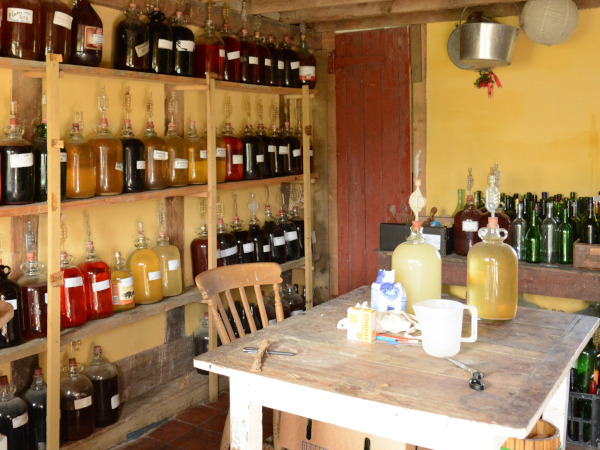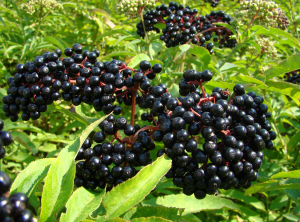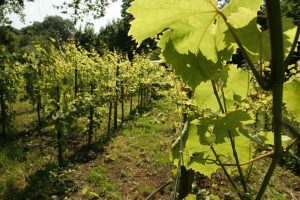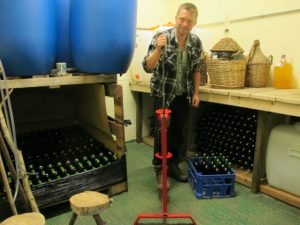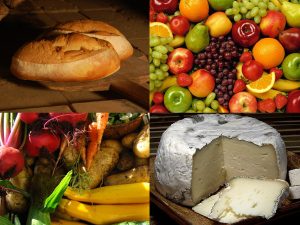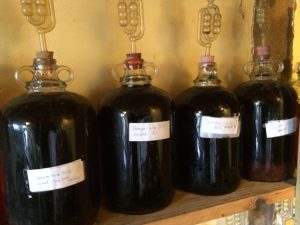Amateur winemakers are not a uniform bunch. We are diverse and unconstrained by market forces or labeling laws, or much of any legal prohibition except good common sense and a prohibition on making more than 200 gallons per family per year. Or selling any of that wine.
But the laws of nature still apply: guidelines on additives should be observed and the rules of good winemaking followed. Like professionals, we strive to make good, clean, clear and tasty wine. And to make good wine, we amateurs should be organized just like our cousins, the professionals. Professionals have much more to manage, from blending to staffing, but we non-professional winemakers are usually also the wine maker, manager and cellar rat all rolled into one person. We still have much to do. Inspired by the Vintners Institute’s Seven Stages of Winemaking, I’ll attempt to catalog some of the many challenges each month offers up to the non-professional winemaker.
Grapes don’t celebrate New Year’s, so January doesn’t begin a winemaker’s year. Although harvest may start winemaking, an amateur must anticipate the harvest and prepare for the flurry of activity that comes at the end of the year. Our year must begin by planning for success. The coming of winemaking catalogs in summer, like swallows returning to Capistrano, herald the start of a new winemaking year.
July and August: A New Adventure Dawns
Anticipating a journey can often be as rewarding as the journey itself, sometimes more so. Anticipation can enhance concentration and bring a rush of dopamine-infused excitement. Whereas delaying planning and experiencing last minute frustrations may not bring hoped for results, what was once called a “bummer.” Double your pleasure by planning and getting ready to receive your new harvest in early to midsummer.
By August, current grape growing conditions may become clearer and harvest size and quality begin to take shape. Nature, of course, has its many “October” surprises, so it’s all a “guesstimate” as to the quality and style of the grape harvest and availability of particular varietals. It’s these conditions that should guide your winemaking choices and styles of wine: Hot year, California style may serve. In a cool or wet year, perhaps in a German style, with a touch of sweetness to balance the acidity. Consider planning to make what is more likely be a success in the bottle, rather than trying to make what takes your fancy.
Having sketched your winemaking plan, it’s time to inventory your winemaking supplies. If you haven’t secured your current year’s grapes, yeast choices may come later. But, testing and fermenting supplies are always necessary. Inventory your wine cupboard contents and consider what you will need for the whole winemaking year, such as SO2, PH testing solution, or how many bottles are on hand or types of closures.
So too, the onerous job of sanitizing carboys and harvest machinery, such as crushers, makes them available at harvest with just a rinse. Getting mundane jobs out of the way early de-clutters harvest time. These are chores you don’t want to deal with when harvest heats up.
September and October: Bounty
Christmas comes once a year? Not to avid winemakers. Harvest starts our holiday season. This season is the season where we will make our greatest wine, until the potential of next year, of course. And nature delivers the gifts of grapes and juice, rather than delivered by Santa Claus. Unless, of course, you are Santa, who is known to make excellent wine.
Harvest time is the time of pre-fermentation testing and maceration on skins, followed by the first inoculation with a yeast of choice. Some may choose to perform a “natural” fermentation, which has its own protocol. If desired, a second fermentation of malic bacteria can be co-inoculated within a day or two of yeast inoculation, or otherwise at the end of the yeast fermentation.
If performing a natural fermentation, it’s probably wise to make a “starter” solution to lessen the fermentation lag time. Also, SO2 additions at the crush should be lower to avoid killing some of the desirable wild yeasts. Also lower the SO2 if co-inoculating with malic bacteria as you need less than 25ppm for the bacteria to thrive.
These months are very busy times with testing, adding appropriate nutrients, stirring the must and using your nose to detect any fermentation problems. This is where your summer prep pays off. That prep gives you more time to monitor the wine and to keep good notes. Record keeping may slip a bit if you are trying to do too many things at once.
November and December: The Wine Takes Form
This is a time of finishing and aging. Depending on when fermentation commenced and on whether it was a hot, fast fermentation or a cold, slow one, fermentation should be slowing and the must or juice begins its journey toward becoming wine. Residual sugar should be checked for continuing fermentation. Final nutrient additions are made followed by a splash-racking to re-energize sluggish yeast. If not co-inoculated, malolactic bacteria can be added when the sugar fermentation is practically completed. This additional fermentation will take as one to many months to complete. The wine is without SO2 protection during malolactic fermentation and will need to be monitored for spoilage. With any additional fermentation, the wine will continue to roil and bubble and thus will not clear until that process is finished.
January and February: Nearing the Finish Line
Aging of the “bulk wine” commences with the completion of all fermentation. Beware of assuming that a wine without bubbles or one partially clear is finished. Before sulfating the wine, its status should be determined. Both a sugar and malic re-fermentation can be difficult or impossible to restart in the presence of substantial amounts of sulfite. Check first. Add later.
Occasionally test sugar levels to monitor the wine progress. Sugar should be tested only with a hydrometer or a chemical test, never a refractometer which will be inaccurate due to the refractive qualities of the now present alcohol. Malic fermentation can be tested now. More about that below.
If all fermentation is completed, the must or juice is now wine. It should be sulfated and allowed to settle. If lees stirring is desired, it can commence now. Some stirring may be desirable to avoid off aromas. Some winemakers add 80 to 100 ppm of sulfite at this point to carry the wine through aging, with final levels checked before bottling.
If not in barrel, oak additions can be made using chips, cubes or beans. Larger oak staves are also sometimes used. Each has its own extraction period with chips being very quick and very powerful. I find cubes can react in a lively way, perhaps faster acting than the manufacturers recommend. Going slow is a good idea, as amounts vary with taste. Over use of oak can be a problem, extending the aging time or leaving an unpleasant taste on the tongue. Fining may help that problem, though.
March and April: Maturity Assessment
White wine ages differently from red wine, but now may be ready to fine for clarity prior to cold stabilizing and bottling. But only if malolactic fermentation is completed. Malolactic fermentation can be difficult and may linger on in fits and starts. The lees should be at the bottom of the carboy. White wines should be protein stabilized with bentonite or other fining agent and if not crystal clear, an additional fining agent with an opposite charge.
March and April are cold months in the north and the weather assists in cold stabilization with a free freezer. We Northerners should get something for suffering through the frigid winters! Cold stabilization causes unstable tartaric acid to drop out of solution making white wines more attractive in bottle. I like to do this after I have completed fining as the tartaric crystals can seal the lees and fining agent for easier, cleaner racking.
With cool climate reds, this can be part of an acid reduction program. If you have refrigeration capacity (lucky you), this can be done anytime.
Some white wines may be ready to bottle, especially if filtered.
May and June: Finishing and Bottling
In the vineyard grape vines are budding out, starting a new wine growing year. Wine in the cellar may be approaching the end of the creation stage and may be ready to bottle. Both red and white wines may be checked for final, pre-bottling, PH and adjusted up or down. Acid levels change during fermentation and can be adjusted with acid additions, primarily tartaric acid or reduced with potassium carbonate. Calcium carbonate is difficult to clear and may leave a residual taste. SO2 levels should be checked.
The new wine may now start to show its personality and flavor profile. Tasting each wine can give a sense of whether this wine can stand on its own, or needs an intervention. Blending can strengthen a wine by adjusting the wine’s PH levels or help to fill in a flavor hole. Acidic wine may have the appropriate flavors, but may be too vibrant on the palate. A little sugar can mellow out the edges. Sweetened wine can be safely bottled after all fermentation is completed and with potassium sorbate in combination with sulfite additions.
Red wines can be bottled at this point, unless you prefer to give the wine extended bulk aging in carboy or in barrel. Some winemakers prefer to wait a year to bottle. If so, blending can occur after aging. My habit is to bottle at this time to free up space and to spare me the chore of constant monitoring of the carboys for spoilage, topping up and sulfite levels. There are positives and negatives for each method.
Before bottling it is imperative that the wine be checked for fermentation status. A hydrometer should read .999 or “0.” If significantly higher, you have a stuck fermentation. Restarting a stopped or “stuck” fermentation is the same as starting a sparkling wine fermentation. See The Sparkling Wine Project Part Two: Bottling.
This measurement also confirms the final alcohol level, by comparing the final hydrometer reading to the initial reading.
Malolactic fermentation testing should show no lactic acid present. If lactic acid is present, then a fermentation has started but is incomplete. Bottling should not occur if there is non-stabilized residual sugar, or both lactic acid and malic acid. This could lead to fizzy bottles or expelled corks.
Bottling your new wine is the final act of your epic journey from grapes, some of which may be from our own vineyard, to wine in bottle. But this will be nothing, no nothing, compared to the incredible wine you will make this next season.
First published on the Kourofsky Wine blog

